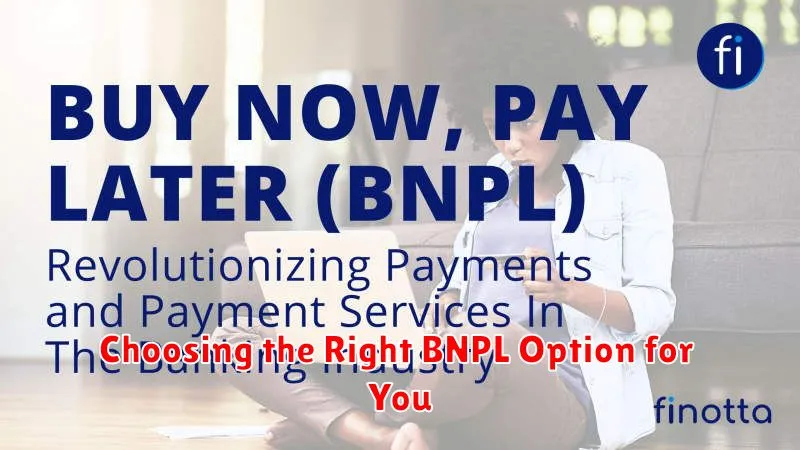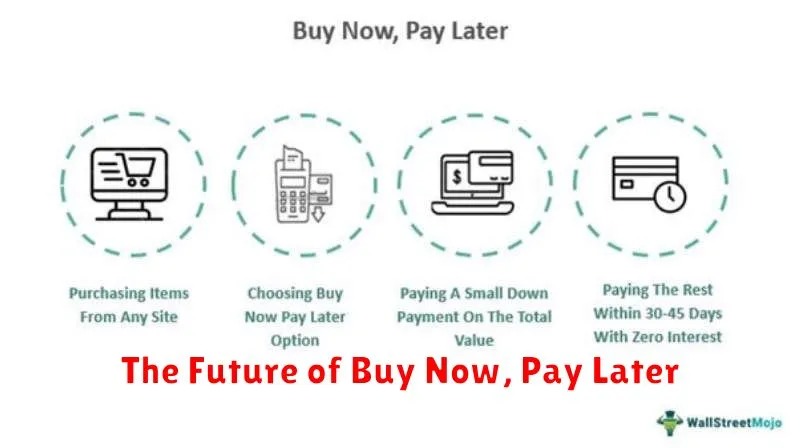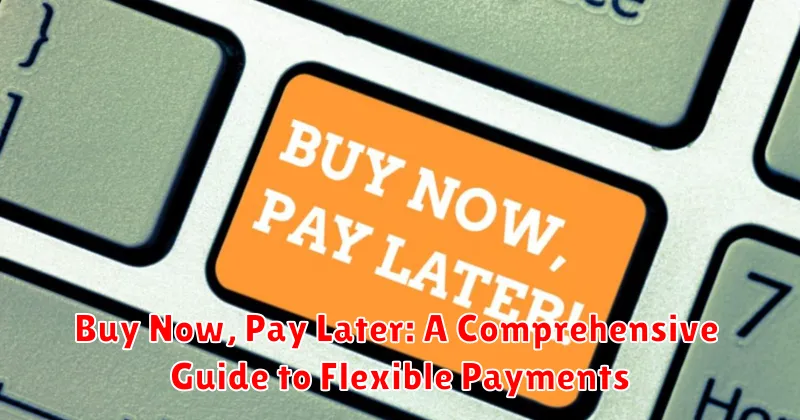Navigating the world of online and in-store shopping can be overwhelming with various payment options available. Buy Now, Pay Later (BNPL) has emerged as a popular choice, offering consumers increased flexibility in managing their purchases. This comprehensive guide delves into the intricacies of BNPL, examining its benefits, potential drawbacks, and crucial factors to consider before utilizing these flexible payment plans. Whether you’re a seasoned shopper or new to e-commerce, understanding the nuances of Buy Now, Pay Later is essential for informed financial decision-making.
Buy Now, Pay Later services allow consumers to make purchases and spread the cost over time, often interest-free. This guide explores the inner workings of BNPL, comparing various providers and highlighting the key features to look for. We’ll also cover important aspects like credit score impact, potential fees, and responsible usage of flexible payment options. By the end of this guide, you’ll be equipped with the knowledge to decide if Buy Now, Pay Later is the right choice for your payment needs, empowering you to shop smart and manage your finances effectively.
What is Buy Now, Pay Later?
Buy Now, Pay Later (BNPL) is a short-term financing option that allows consumers to make purchases and pay for them over time, often without incurring interest charges. It’s essentially a point-of-sale loan that splits a purchase into smaller, more manageable installments.
BNPL services are typically offered at checkout, either online or in physical stores. After selecting BNPL as a payment method, customers typically undergo a quick credit check. Approved shoppers can then take their purchase home immediately and begin making payments according to the chosen plan.
These plans typically offer interest-free periods if payments are made on time and in full. This makes BNPL an attractive alternative to traditional credit cards, especially for smaller purchases. However, it is crucial to understand the terms and conditions of each BNPL offer to avoid potential fees and interest charges.
How Buy Now, Pay Later Works
The BNPL process is generally straightforward. At checkout, when presented with payment options, you select the Buy Now, Pay Later option through a partnered provider. A soft credit check is often performed, which usually doesn’t impact your credit score. Upon approval, you make a small down payment, typically a fraction of the total purchase price.
The remaining balance is then divided into a series of installments. These payments are usually scheduled over a short period, such as a few weeks or months. Payment methods vary; some providers automatically debit your linked bank account or credit card, while others offer manual payment options.
Interest charges depend on the specific BNPL plan and provider. Some offer 0% interest if payments are made on time, while others charge a fixed or variable APR. It’s crucial to understand the payment schedule and any potential fees associated with late or missed payments before using a BNPL service.
Different Types of BNPL Plans
Buy Now, Pay Later plans come in various forms, each designed to suit different purchasing needs and budgets. Understanding these different plan types is crucial for making informed decisions.
Pay-in-Four
This is the most common BNPL plan. It splits the purchase amount into four equal installments. The first payment is typically due at checkout, with the remaining three paid bi-weekly or monthly.
Longer-Term Financing
Some providers offer longer-term financing options, ranging from six to twenty-four months. These plans often involve larger purchases and may include interest charges, especially for longer durations.
Interest-Bearing vs. Interest-Free
Interest-free plans are attractive as they don’t incur additional costs if payments are made on time. Interest-bearing plans may offer longer repayment periods but will accrue interest over time, potentially increasing the overall cost of the purchase.
In-Store vs. Online
Some BNPL services are specific to online purchases, while others can be used both online and in physical stores. The availability of in-store options often depends on the merchant and the BNPL provider they partner with.
Benefits of Using BNPL Services
Buy Now, Pay Later (BNPL) offers several advantages for consumers seeking flexible payment options. One key benefit is increased affordability. BNPL allows shoppers to purchase items they might not otherwise be able to afford upfront, by spreading the cost into smaller, manageable installments.
Budgeting assistance is another advantage. The predictable payment schedule helps consumers track their spending and avoid unexpected expenses. This can be particularly helpful for larger purchases.
BNPL services also offer convenience. The quick and easy application process eliminates the need for lengthy credit checks and complex paperwork, making purchases faster and more streamlined.
Finally, some BNPL providers offer interest-free periods. This allows consumers to avoid interest charges if they pay off their balance within the specified timeframe, effectively providing a short-term, no-interest loan.
Risks and Drawbacks of BNPL
While BNPL offers appealing flexibility, it’s crucial to understand the potential risks. Overspending is a significant concern. The ease of purchase can lead to accumulating more debt than initially intended, especially if using multiple BNPL services simultaneously.
Hidden fees can also diminish the perceived benefits. Late payment fees, while often touted as avoidable, can quickly accrue if payments aren’t managed carefully. Some providers may also charge administrative or processing fees, increasing the overall cost of the purchase.
Impact on credit score is another important consideration. While some BNPL providers don’t report on-time payments to credit bureaus, late or missed payments can be reported, negatively affecting your credit history. Additionally, some providers conduct hard credit checks during the application process, which can temporarily lower your credit score.
Finally, BNPL can create a false sense of affordability. Breaking down payments into smaller installments might make a purchase seem manageable, but it’s important to evaluate whether you can truly afford the total cost. Failing to budget appropriately for BNPL payments can strain your finances and lead to debt accumulation.
Choosing the Right BNPL Option for You

Selecting the right Buy Now, Pay Later (BNPL) service requires careful consideration of your individual financial situation and spending habits. Several factors differentiate these services, and understanding these differences is crucial for responsible usage.
Interest Rates and Fees: Some BNPL providers charge interest on outstanding balances, while others rely on late payment fees. Carefully examine the fee structure to avoid unexpected costs. Repayment schedules also vary, with some offering weekly installments while others offer monthly. Choose a plan that aligns with your budget and pay schedule.
Credit Limit: Different BNPL providers offer different credit limits. Assess your needs and choose a service that offers an appropriate limit. Avoid overspending and prioritize staying within your budget. Merchant Acceptance is another key factor. Certain BNPL services are more widely accepted than others. Verify that your preferred retailers accept your chosen BNPL provider.
Impact of BNPL on E-Commerce and Retail
Buy Now, Pay Later (BNPL) services have significantly impacted the e-commerce and retail landscape. Increased conversion rates are a key benefit for businesses. By offering BNPL, merchants can lower the barrier to purchase, encouraging customers to complete transactions, even for higher-priced items.
Average order values also tend to rise with BNPL integration. Customers are more likely to add items to their cart when the immediate cost is reduced, leading to larger purchases. This positive impact on sales is a major driver of BNPL adoption by retailers.
Furthermore, BNPL influences customer acquisition. The flexible payment option attracts new shoppers, particularly younger demographics, who may be averse to traditional credit options. This expanded customer base can contribute to overall business growth.
However, the integration of BNPL also presents challenges for retailers. Merchant fees associated with these services can cut into profit margins, requiring careful cost-benefit analysis. Managing the complexities of multiple BNPL providers can also be an operational hurdle.
The Future of Buy Now, Pay Later

The BNPL landscape is constantly evolving. Several key trends are likely to shape its future, impacting both consumers and businesses.
Increased Integration with Existing Platforms: We can expect to see BNPL options more seamlessly integrated into e-commerce platforms and even in-store point-of-sale systems. This will make using BNPL even more convenient for consumers.
Expansion into New Markets and Product Categories: BNPL is likely to expand beyond traditional retail purchases and into areas like healthcare, travel, and education. This broader application will increase its overall market penetration.
Emphasis on Enhanced Regulation: As the BNPL sector matures, more robust regulations are anticipated to ensure responsible lending practices and protect consumers from accruing unsustainable debt. This may involve stricter credit checks and greater transparency in fee structures.
Focus on Financial Wellness Tools: Providers may increasingly offer budgeting and financial management tools integrated within their platforms to empower consumers to manage their BNPL payments effectively and avoid financial pitfalls.
Regulations and Consumer Protection for BNPL
As Buy Now, Pay Later (BNPL) services gain popularity, regulatory scrutiny has increased to ensure consumer protection. Lack of standardized regulations has raised concerns regarding potential risks such as overspending and debt accumulation.
Current regulations vary widely depending on the jurisdiction. Some treat BNPL like traditional credit, while others have fewer requirements. Key areas of focus for regulators include disclosure requirements, ensuring consumers fully understand the terms and conditions, and credit reporting, to accurately reflect BNPL usage on credit scores.
Debt collection practices are also under review, with emphasis on fair and ethical treatment of consumers. Additionally, regulators are exploring ways to prevent discriminatory lending practices and promote responsible lending within the BNPL sector.

